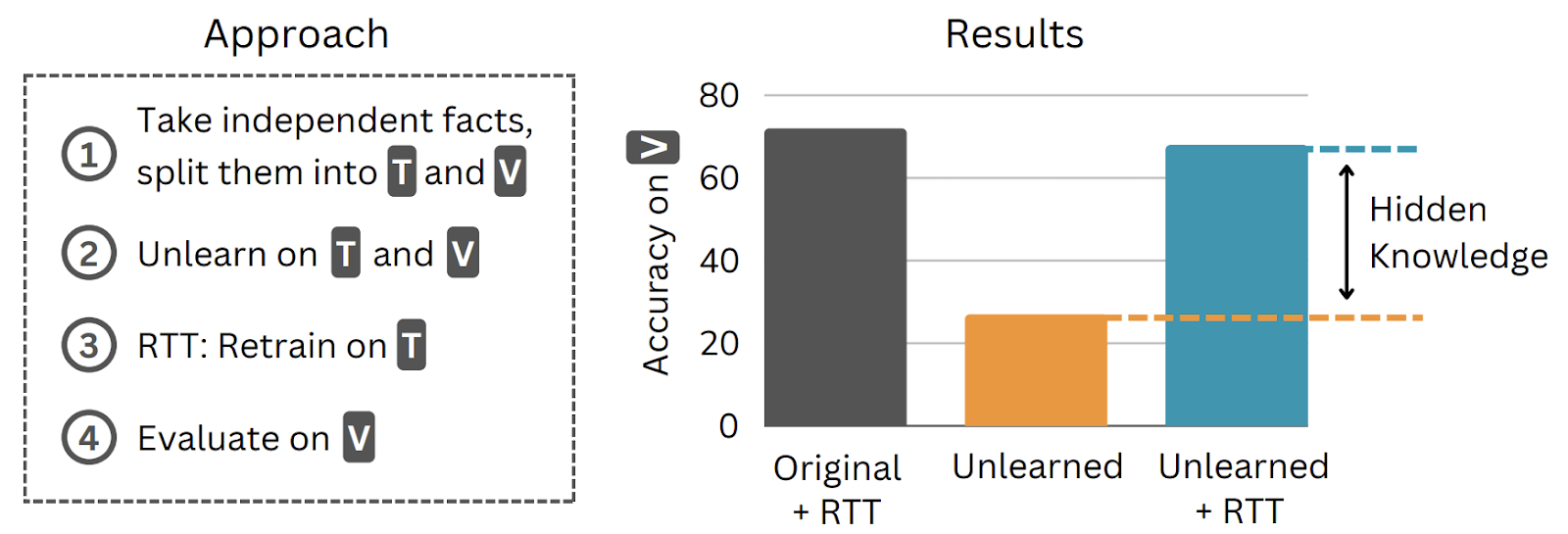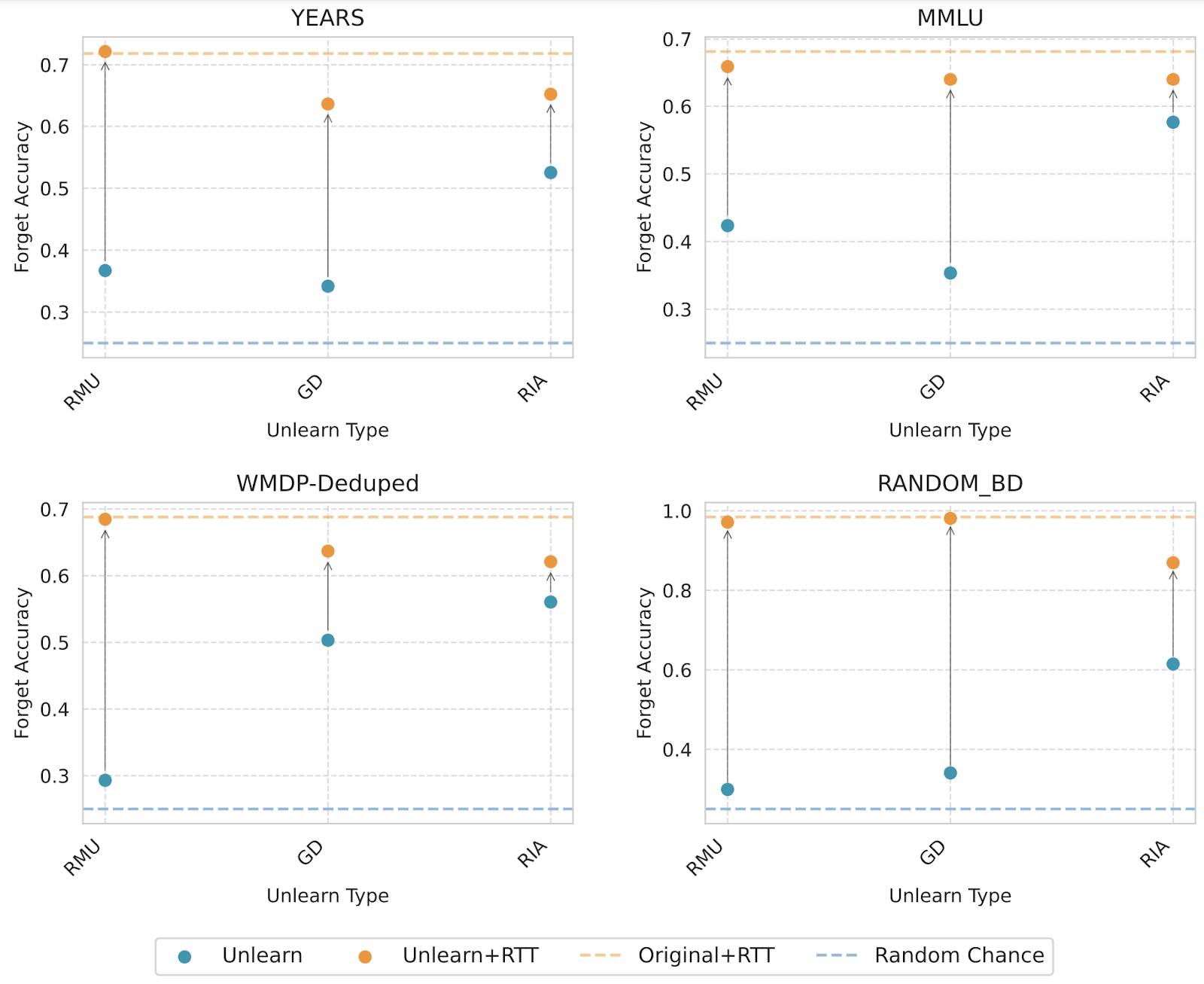We committed an important mistake in the dataset creation process for random birthdays. We will rerun our experiments on this dataset and release an update. Early results suggest that unlearning on this dataset works relatively well, which suggests that experimenting with unlearning synthetic facts that a model was fine-tuned on might not be a reliable way of studying unlearning.
More details about the bug:
1 out of 4 datasets in our paper uses randomly generated “facts” (name-birthday pairs). Thanks to an ICLR reviewer, we found that the initial version of this dataset had duplicate names with different birthdays, so we fixed the bug and reran our experiments.
In the new, fixed dataset, we cannot recover information with our approach (RTT) after applying unlearning. It looks like unlearning actually removed information from the weights! (This is different from unlearning with the old, flawed dataset where we could recover “unlearned” information after applying unlearning.) Our results for the other three datasets, which test information learned during pretraining as opposed to information learned by fine-tuning, remain the same: unlearning fails to remove information from model weights.
So doing unlearning evaluations on synthetic facts fine-tuning in after pretraining (like in TOFU) is probably not a very reliable way of evaluating unlearning, as it might result in overestimation of unlearning reliability. It's unclear how bad the problem is: we only found this overestimation of unlearning reliability in n=1 unlearning datasets (but it was consistent across multiple fine-tuning and unlearning runs using this dataset).
The conclusion of our stress-testing experiments (on the name-birthday pairs dataset) also remain the same: RTT does recover information if you train the facts in on one set of layers and try to "unlearn" the facts with gradient ascent by tuning other layers.
We updated the results in the arxiv paper (with a historical note in the Appendix): https://arxiv.org/abs/2410.08827
Good fine-tuning robustness (i.e. creating models which attackers have a hard time fine-tuning to do a target task) could make the framework much harder to apply. The existence of such technique is a main motivation for describing it as an adversarial framework rather than just saying "just do fine-tuning". All existing tamper resistant technique can be broken (Repnoise fails if you choose the learning rate right, Tamper-resistant fine-tuning method fails if you use LoRA ...), and if you use unlearning techniques which look like that, you should really do the basic fine-tuning variations that break Repnoise and Tamper-resistant fine-tuning when evaluating your technique.
This creates a bit of FUD, but I expect the situation to be much less bad than in the jailbreak robustness literature, since I expect fine-tuning robustness to be much more offense-favored than jailbreak robustness (i.e. even playing the attacker a little gets you massive returns, whereas in jailbreak robustness it's super annoying to play the attacker properly) because in fine-tuning robustness it is much harder to patch individual attacks than in jailbreak robustness. I think good fine-tuning robustness (given full access and decent resources to the attacker) is hopeless, and this makes the evaluation of unlearning using the method described here possible.
But if fine-tuning robustness was ever successful, this would make the situation much more scary: maybe you could make your "unlearning" method model "forget" the hazardous info on most prompts, but "remember it" if there is a password in the prompt (i.e. people can't extract the information if they don't know what the password is, even with white-box access to the weights). If this were the case, there would be something horrific going on because the hazardous information would clearly still in the weights, but the method described in this post would claim there isn't. If you applied the same unlearning technique in a more straightforward way (without the password backdoor) and people didn't manage to extract the information, I would be afraid the information would still be there.
Side note: skills vs facts. I framed some of the approaches as teaching false facts / removing some facts - and concrete raw facts is often what is the easiest to evaluate. But I think that the same approach can be used to remove the information that makes LLMs able to use most skills. For example, writing Python code requires the knowledge of the Python syntax and writing recursive functions requires the knowledge of certain patterns (at least for current LLMs, who don’t have the ability to rederive recursive from scratch, especially without a scratchpad), both of which could be unlearned like things that are more clearly “facts”.
If you read e.g. "Fact Finding: Attempting to Reverse-Engineer Factual Recall on the Neuron Level", current thinking in mechanistic interpretability is that simple memorization of otherwise random facts (i.e. ones where there are no helpful "rules of thumb" to get many cases right) uses different kinds of learned neural circuits that learning of skills does. If this were in fact the case, then unlearning of facts and skills might have different characteristics. In particular, for learnt skills, if mechanistic interpretability can locate and interpret the learned circuit implementing a skills, then we can edit them directly (as has been done successfully in a few cases). However, we've so far had no luck at interpreting neural circuitry for large collections of basically-random facts, and there are some theoretical arguments suggesting that such circuitry may be inherently hard to interpret, at least using current techniques.
knowing if the intentions of a user are legitimate is very difficult
This sounds more like a security and authentication problem than an AI problem.

